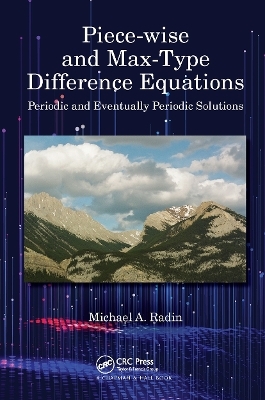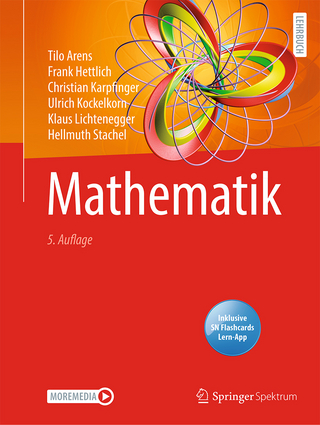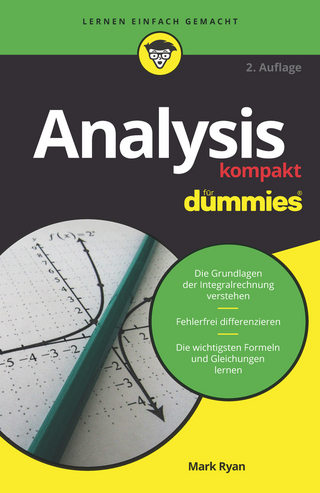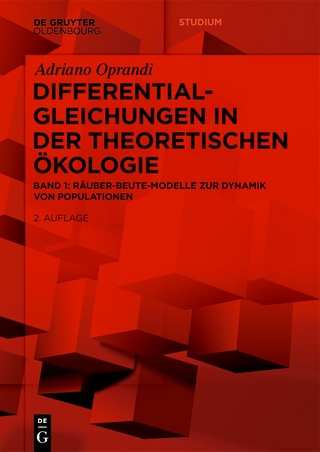
Piece-wise and Max-Type Difference Equations
Chapman & Hall/CRC (Verlag)
978-0-367-55102-5 (ISBN)
- Titel z.Zt. nicht lieferbar
- Versandkostenfrei innerhalb Deutschlands
- Auch auf Rechnung
- Verfügbarkeit in der Filiale vor Ort prüfen
- Artikel merken
Piece-wise and Max-Type Difference Equations: Periodic and Eventually Periodic Solutions is intended for lower-level undergraduate students studying discrete mathematics.
The book focuses on sequences as recursive relations and then transitions to periodic recursive patterns and eventually periodic recursive patterns. In addition to this, it will also focus on determining the patterns of periodic and eventually periodic solutions inductively. The aim of the author, throughout this book, is to get students to understand the significance of pattern recognition as a mathematical tool.
Key Features
Can provide possible topics for undergraduate research and for bachelor’s thesis
Provides supplementary practice problems and some open-ended research problems at the end of each chapter
Focusses on determining the patterns of periodic and eventually periodic solutions inductively
Enhances students’ algebra skills before moving forward to upper level courses
Familiarize students with the topics before they start undergraduate research by providing applications.
Michael A. Radin earned his Ph.D. at the University of Rhode Island in 2001 and is currently an associate professor of mathematics at the Rochester Institute of Technology. Michael started his journey analyzing difference equations that portray periodic and eventually periodic solutions as part of his Ph.D. thesis and has several publications on boundedness and periodic nature of solutions of rational difference equations, max-type difference equations and piecewise difference equations. Michael published several papers together with his Master's students and undergraduate students at RIT and has publications with students and colleagues from Riga Technical University and the University of Latvia. Michael also has publications in applied mathematics and related topics such as Neural Networking, Modelling Extinct Civilizations and Modelling Human Emotions. In addition, Michael organized numerous sessions on difference equations and applications at the annual American Mathematical Society meetings and presents his research at international conferences as the Conference on Mathematical Modelling and Analysis and the Volga Neuroscience Meeting. Recently Michael published four manuscripts on international pedagogy and has been invited as one of the keynote speakers at several international and interdisciplinary conferences such as the International Scientific Conference Society, Integration and Education held annually at the Rezekne Technical Academy in Latvia. Michael taught courses and conducted seminars on these related topics during his spring 2009 sabbatical at the Aegean University in Greece and during his spring 2016 sabbatical at Riga Technical University in Latvia. In addition, Michael taught a new course on "Introduction to Recognition of Patterns and Deciphering of Patterns" at Rezekne Technical Academy in Rezekne, Latvia in May 2019. Michael's aim is to inspire students to learn. Recently, Michael had the opportunity to implement his hands-on teaching and learning style in the courses that he regularly teaches at RIT and during his spring 2016 sabbatical in Latvia. This method confirmed to work very successfully for him and his students, kept the students stimulated and engaged and improved their course performance ([26], [23]). During his spare time Michael spends time outdoors and is an avid landscape photographer. In addition, Michael is an active poet and has several published poems about nature in the LeMot Juste. Furthermore, Michael published an article on "Re-Photographing the Baltic Sea Scenery in Liepaja: Why photograph the same scenery multiple times" in the Journal of Humanities and Arts 2018. Michael also recently published a book on "Poetic Landscape Photography" with JustFiction Edition 2019. Spending time outdoors and active landscape photography widens and expands Michael's understandings of nature's patterns and cadences
Contents
Preface vii
Acknowledgments ix
Author xi
Introduction 1
1.1 Recursive Sequences . . . . . . . . . . . . . . . . . . . . . . . 3
Order and Explicit Solution of a ∆.E. . . . . . . . . . . . . . 5
Non-Autonomous Difference Equations . . . . . . . . . . . . 6
1.4 Periodic Sequences . . . . . . . . . . . . . . . . . . . . . . . . 7
Alternating Periodic Cycles . . . . . . . . . . . . . . . . . . . 12
Specific Patterns of Periodic Cycles . . . . . . . . . . . . . . 13
Eventually Periodic Sequences . . . . . . . . . . . . . . . . . 14
1.8 Piece-wise Sequences . . . . . . . . . . . . . . . . . . . . . . 18
1.9 Chapter 1 Exercises . . . . . . . . . . . . . . . . . . . . . . . 20
Linear Difference Equations 25
Autonomous Linear Difference Equations . . . . . . . . . . . 26
2.2 Non-Autonomous Linear ∆.E.’s . . . . . . . . . . . . . . . . 27
2.2.1 Multiplicative Form of Eq. (2.5) . . . . . . . . . . . . . 27
2.2.2 Additive Form of Eq. (2.5) . . . . . . . . . . . . . . . . 31
2.3 Chapter 2 Exercises . . . . . . . . . . . . . . . . . . . . . . . 40
Riccati Difference Equations 43
3.1 First-Order Riccati ∆.E. . . . . . . . . . . . . . . . . . . . . 43
3.2 Second-Order Riccati ∆.E. . . . . . . . . . . . . . . . . . . . 50
3.3 Chapter 3 Exercises . . . . . . . . . . . . . . . . . . . . . . . 60
Piece-wise Difference Equations 63
4.1 The Collatz Conjectures . . . . . . . . . . . . . . . . . . . . 64
4.2 The Tent-Map . . . . . . . . . . . . . . . . . . . . . . . . . . 65
The Autonomous Neuron Model . . . . . . . . . . . . . . . . 72
Autonomous Neuron Model when β = 1 . . . . . . . . 79
Non-Autonomous Neuron Model . . . . . . . . . . . . . . . . 82
Non-Autonomous Neuron Model when β0β1 = 1 . . . 88
4.5 The Williamson Model . . . . . . . . . . . . . . . . . . . . . 92
4.6 The West Nile Epidemics Model . . . . . . . . . . . . . . . . 93
4.7 Chapter 4 Exercises . . . . . . . . . . . . . . . . . . . . . . . 93
5 Max-Type Difference Equations 97
5.1 The Autonomous Case (Eq. [5.1]) . . . . . . . . . . . . . . . 97
Eventually Periodic with Period-2 . . . . . . . . . . . 100
Eventually Periodic with Period-4 . . . . . . . . . . . 109
Eventually Periodic with Period-3 . . . . . . . . . . . 117
Eventually Constant with K = 1 . . . . . . . . . . . . 125
5.2 The Non-Autonomous Case (Eq. [5.2]) . . . . . . . . . . . . . 130
Eventually Periodic with Period-2 . . . . . . . . . . . 132
Eventually Periodic with Period-4 . . . . . . . . . . . 140
Eventually Periodic with Period-6 . . . . . . . . . . . 144
5.3 Chapter 5 Exercises . . . . . . . . . . . . . . . . . . . . . . . 147
6 Appendices 149
6.1 Patterns of Sequences . . . . . . . . . . . . . . . . . . . . . . 149
6.2 Alternating Patterns of Sequences . . . . . . . . . . . . . . . 149
6.3 Finite Series . . . . . . . . . . . . . . . . . . . . . . . . . . . 150
Convergent Infinite Series . . . . . . . . . . . . . . . . . . . . 150
Periodicity and Modulo Arithmetic . . . . . . . . . . . . . . 151
Alternating Periodicity . . . . . . . . . . . . . . . . . . 151
Patterns as an Initial Value Problem . . . . . . . . . . . . . 152
Specific Periodic Patterns . . . . . . . . . . . . . . . . . . . . 153
Bibliography 155
Index 157
| Erscheinungsdatum | 21.04.2022 |
|---|---|
| Zusatzinfo | 157 Illustrations, color |
| Sprache | englisch |
| Maße | 156 x 234 mm |
| Gewicht | 320 g |
| Themenwelt | Mathematik / Informatik ► Mathematik ► Analysis |
| Technik ► Umwelttechnik / Biotechnologie | |
| ISBN-10 | 0-367-55102-0 / 0367551020 |
| ISBN-13 | 978-0-367-55102-5 / 9780367551025 |
| Zustand | Neuware |
| Informationen gemäß Produktsicherheitsverordnung (GPSR) | |
| Haben Sie eine Frage zum Produkt? |
aus dem Bereich


